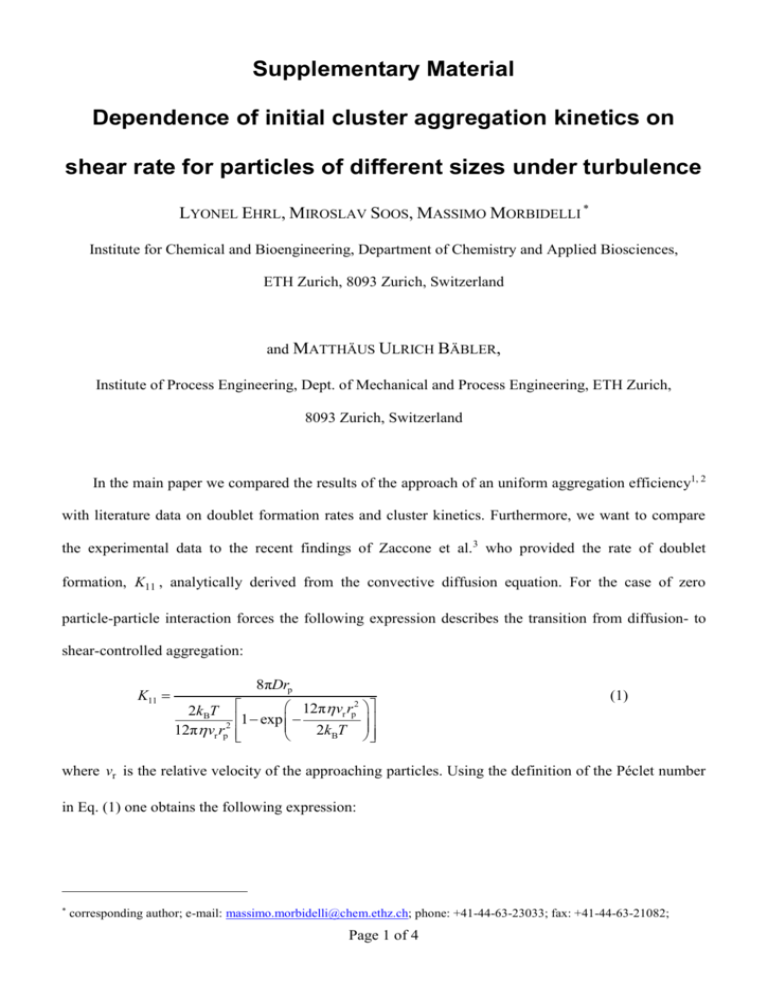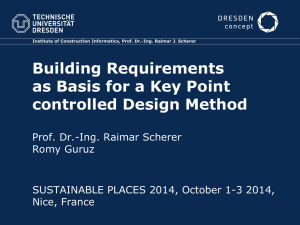AIC_11923_sm_suppinfo
advertisement

Supplementary Material Dependence of initial cluster aggregation kinetics on shear rate for particles of different sizes under turbulence LYONEL EHRL, MIROSLAV SOOS, MASSIMO MORBIDELLI * Institute for Chemical and Bioengineering, Department of Chemistry and Applied Biosciences, ETH Zurich, 8093 Zurich, Switzerland and MATTHÄUS ULRICH BÄBLER, Institute of Process Engineering, Dept. of Mechanical and Process Engineering, ETH Zurich, 8093 Zurich, Switzerland In the main paper we compared the results of the approach of an uniform aggregation efficiency1, 2 with literature data on doublet formation rates and cluster kinetics. Furthermore, we want to compare the experimental data to the recent findings of Zaccone et al.3 who provided the rate of doublet formation, K11 , analytically derived from the convective diffusion equation. For the case of zero particle-particle interaction forces the following expression describes the transition from diffusion- to shear-controlled aggregation: K11 8πDrp 2kBT 12π vr rp2 12π vr rp2 1 exp 2kBT (1) where vr is the relative velocity of the approaching particles. Using the definition of the Péclet number in Eq. (1) one obtains the following expression: * corresponding author; e-mail: massimo.morbidelli@chem.ethz.ch; phone: +41-44-63-23033; fax: +41-44-63-21082; Page 1 of 4 K11 8πDrp 1 G rp 2Pe vr (2) v 1 exp 2Pe r G rp To be able to compute K11 one needs to have an expression for vr . Using von Smoluchowskis’ rectilinear approach,4 neglecting the hydrodynamic interactions between the approaching particles, where vr G 2rp , one obtains:3 K11 8πDrp (3) 1 1 exp 4Pe 4Pe However, as it was shown by van de Ven and Mason5 and Zeichner and Schowalter6 the effect of hydrodynamic interactions is significant leading to a curvi-linear description of doublet formation. The deviations from the recti-linear approach can be accounted for with an aggregation efficiency, doublet kPe0.18 , where the prefactor is a function of the London wavelength, L , and the particle size.5 Thus we suggest to express the relative velocity of the particles according to vr doublet G 2rp kPe0.18 G 2rp , where k f L AH 12kBT 0.18 .5 For the particle sizes investigated here f L can be approximated to be equal to unity.5 Including this into Eq. (2) results in: K11 abPe0.82 1 exp bPe0.82 (4) where a 8kBT 3 and b 4 AH 12kBT 0.18 . We are aware of the fact the term AH kBT in Eq. (4) considers particle-particle interactions which were neglected in the derivation of Eq. (1), but we are encouraged to take this approach, on the one hand, by the recent findings of Lattuada and Morbidelli7 on the use a functional form similar to Eq. (3) to describe K11 also in the presence of particle-particle interactions, and on the other hand, by the fact that in experimental systems AH kBT is usually constant. Consequently, from Eq. (4) n as a function of Pe was determined by calculating 1 log K11 log Pe 1 K11 Pe Pe K11 , resulting in the expression Page 2 of 4 n 0.18 0.82bPe0.82 1 exp bPe0.82 (5) which is plotted as a solid line in Figure 5 of the main paper, for Hamaker constants of (solid) polystyrene, (dashed) silica, and (dash-dotted) titania. For large values of Pe the curvi-linear solution is recovered, which corresponds to the experimental data of the literature and this work, where the rate of aggregation is non-linearly dependent on G with n 0.18 . However, for small values of Pe a transition from purely shear-induced to diffusion-affected aggregation is observed. A change in the Hamaker constant due to different material properties shows little effect on the position of the curve. This indicates little sensitivity of the interplay between Brownian and shear-induced aggregation to attractive inter-particle forces, which is in contrast to the tremendous effect of repulsive inter-particle forces on doublet formation rates under shear as shown by Lattuada and Morbidelli7. The much steeper decay of n with an increase in Pe could be either an effect of the assumptions taken in the derivation of Eq. (1)3 or due to the fact that for shear-induced aggregation doublet formation rates are not capturing the dynamic characteristics of the whole process, as it is the case for static aggregation kinetics.8-10 However, one can conclude that by combining the simple mathematical expression provided by Zaccone et al.3 under the assumption of zero particle-particle interactions with the proper value of the relative velocity of particles the cross-over from shear- to diffusion-controlled aggregation can be captured. For this reasons, we conclude that proper aggregation efficiency models for cluster-cluster aggregation should exhibit a dependency of the exponent n on Pe as observed by measurements and listed in Table 2. 1. 2. Soos, M.; Moussa, A. S.; Ehrl, L.; Sefcik, J.; Wu, H.; Morbidelli, M. Effect of Shear Rate on Aggregates Size and Morphology Investigated under Turbulent Conditions in Stirred Tank. Journal of Colloid and Interface Science. 2008; 319:577-589. Bäbler, M. U. A Collision Efficiency Model for Flow Induced Coagulation of Fractal Aggregates. A.I.Ch.E. Journal. 2008; 54:1748-1760. Page 3 of 4 3. 4. 5. 6. 7. 8. 9. 10. Zaccone, A.; Wu, H.; Lattuada, M.; Morbidelli, M. Charged molecular films on Brownian particles: Structure, interactions, and relation to stability. Journal of Physical Chemistry B. 2008; 112:6793-6802. von Smoluchowski, M. Versuch einer mathematischen Theorie der Koagulationskinetik kolloider Lösungen. Zeitschrift für Physikalische Chemie. 1917; 92:129-168. van de Ven, T. G. M.; Mason, S. G. Microrheology of Colloidal Dispersions. VII. Orthokinetic Doublet Formation of Spheres. Colloid and Polymer Science. 1977; 255:468-479. Zeichner, G. R.; Schowalter, W. R. Use of trajectory analysis to study stability of colloidal dispersion in flow fields. A.I.Ch.E. Journal. 1977; 23:243-254. Lattuada, M.; Morbidelli, M. In Generalized model for the aggregation rate of colloidal nanoparticles and clusters induced by shear in the presence of repulsive interactions, 12th The Nanotechnology Conference and Trade Show, NIST Nanotech, Boston, 2008. Lin, M. Y.; Lindsay, H. M.; Weitz, D. A.; Ball, R. C.; Klein, R.; Meakin, P. Universality in Colloid Aggregation. Nature. 1989; 339:360-362. Lin, M.; Lindsay, H. M.; Weitz, D. A.; Ball, R. C.; Klein, R.; Meakin, P. Universal diffusionlimited colloid aggregation. Journal of Physics: Condensed Matter. 1990; 2:3093-3113. Lin, M.; Lindsay, H. M.; Weitz, D. A.; Klein, R.; Ball, R. C.; Meakin, P. Universal reactionlimited aggregation. Physical Review A. 1990; 41:2005-2020. Page 4 of 4




